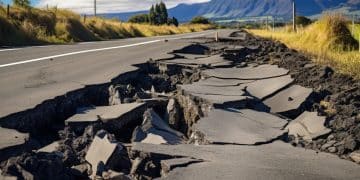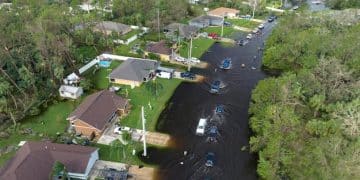How to Prepare Your Family for a Humanitarian Crisis: A US Resident’s Guide

Preparing your family for a humanitarian crisis involves creating a comprehensive plan that includes emergency supplies, communication strategies, evacuation routes, and knowledge of local resources, ensuring your family’s safety and well-being during unexpected events.
In an increasingly unpredictable world, knowing how to prepare your family for a humanitarian crisis: a step-by-step guide for US residents is not just prudent; it’s essential for ensuring their safety and well-being. This guide provides actionable steps to help you create a comprehensive plan.
Understand the Risks and Threats
The first step in preparing for a humanitarian crisis is to understand the specific risks and threats that your family may face in your geographical location. This knowledge will inform your preparedness efforts and allow you to tailor your plan to address the most likely scenarios.
Identify Potential Hazards
Start by identifying the natural disasters, technological accidents, and civil unrest events that are most likely to occur in your area. Common examples in the US include hurricanes, earthquakes, wildfires, floods, tornadoes, and winter storms. Consider also the potential for man-made disasters, such as industrial accidents or acts of terrorism.
Assess Your Vulnerabilities
Next, assess your family’s vulnerabilities to these hazards. Consider factors such as your location (e.g., living in a flood zone or near a chemical plant), the age and health of family members, and any disabilities that may affect their ability to respond to an emergency.
- Research local emergency management plans and resources.
- Subscribe to local emergency alerts and warnings.
- Stay informed about potential threats through news and weather reports.
By understanding the risks and threats in your area, you can prioritize your preparedness efforts and create a plan that addresses your family’s specific needs and vulnerabilities. This knowledge will empower you to take proactive steps to protect your loved ones in the face of a crisis.
Develop a Family Emergency Plan
A well-developed family emergency plan is the cornerstone of crisis preparedness. This plan should outline how your family will communicate, evacuate, and shelter in place during various types of emergencies. It should be a living document that is regularly reviewed and updated to reflect changes in your family’s circumstances.
Establish Communication Protocols
Communication is crucial during a crisis, but normal channels may be disrupted. Establish alternative communication methods, such as a designated out-of-state contact person, texting (which often works when phone calls don’t), and a pre-arranged meeting place.
Plan Evacuation Routes
Identify multiple evacuation routes from your home, neighborhood, and workplace. Practice these routes with your family so that everyone knows how to get to safety quickly and efficiently. Designate a safe meeting point outside of your immediate area in case you become separated.

- Conduct regular family meetings to discuss and update the emergency plan.
- Practice the evacuation routes and shelter-in-place procedures.
- Ensure that all family members know the location of emergency supplies.
Developing a comprehensive family emergency plan is a vital step in preparing for a humanitarian crisis. By establishing communication protocols, planning evacuation routes, and practicing emergency procedures, you can increase your family’s chances of staying safe and connected during a disaster.
Build an Emergency Supply Kit
An emergency supply kit is a collection of essential items that your family will need to survive for several days without outside assistance. This kit should include food, water, medical supplies, tools, and other items that will help you cope with the challenges of a humanitarian crisis.
Stock Up on Food and Water
Store at least a three-day supply of non-perishable food and water for each family member. Choose foods that are easy to prepare and require no refrigeration, such as canned goods, granola bars, and dried fruit. Store water in sealed containers and consider adding water purification tablets or a filter.
Gather Essential Supplies
In addition to food and water, your emergency supply kit should include a first-aid kit, medications, a flashlight, a battery-powered radio, a multi-tool, sanitation supplies, and personal hygiene items. Also, don’t forget copies of important documents.
Building a well-stocked emergency supply kit is a critical aspect of crisis preparedness. By ensuring that you have an adequate supply of food, water, and essential supplies, you can increase your family’s resilience and ability to cope with the challenges of a humanitarian crisis. Regularly check and replenish your kit to ensure that the items remain in good condition and are not expired.
Secure Your Home and Property
Taking steps to secure your home and property can help protect your family from the physical dangers of a humanitarian crisis. This includes reinforcing your home against potential hazards, mitigating risks, and taking preventative measures to minimize damage.
Reinforce Your Home
Depending on the specific threats in your area, consider reinforcing your home against wind, floods, or earthquakes. This may involve installing storm shutters, elevating your home, or bolting it to the foundation.
Mitigate Potential Hazards
Identify and mitigate potential hazards around your property, such as trimming trees that could fall on your home, clearing gutters to prevent water damage, and securing propane tanks and other hazardous materials.

- Review your insurance policies to ensure adequate coverage for potential disasters.
- Document your property with photos and videos for insurance purposes.
- Consider investing in a generator for backup power.
Securing your home and property is an essential step in preparing for a humanitarian crisis. By reinforcing your home, mitigating potential hazards, and taking preventative measures, you can reduce the risk of damage and protect your family from physical harm. Regularly inspect and maintain your property to ensure that it is prepared for potential disasters.
Learn First Aid and CPR
In a humanitarian crisis, access to professional medical care may be limited or unavailable. Learning basic first aid and CPR can empower you to provide immediate assistance to injured family members or others in need. These skills can be life-saving in emergency situations.
Enroll in a First Aid Course
Take a certified first aid and CPR course offered by organizations such as the American Red Cross or the American Heart Association. These courses will teach you how to assess injuries, administer basic medical care, and perform CPR.
Practice Your Skills
Regularly practice your first aid and CPR skills to maintain proficiency. Consider purchasing a first aid training kit or mannequin to simulate real-life scenarios. Review your knowledge and skills periodically to refresh your memory.
Learning first aid and CPR is a valuable investment in your family’s safety and well-being. By acquiring these life-saving skills, you can be prepared to provide immediate medical assistance in the event of a humanitarian crisis. Encourage all family members to learn first aid and CPR to increase your collective preparedness.
Stay Informed and Adapt Your Plan
The situation during a humanitarian crisis can change rapidly, so it’s important to stay informed and adapt your plan as needed. This involves monitoring news and weather reports, following instructions from emergency responders, and being flexible in your approach.
Monitor Emergency Alerts
Stay tuned to local news and weather reports for updates on the crisis and instructions from emergency responders. Pay attention to evacuation orders, shelter locations, and other important information.
Be Flexible and Adaptable
Be prepared to adapt your plan based on the evolving situation. If your evacuation route is blocked, find an alternative route. If your designated shelter is full, seek another safe location. Flexibility and adaptability are key to survival in a crisis situation.
- Communicate regularly with family members and update them on the situation.
- Follow the advice and instructions of emergency responders.
- Be prepared to shelter in place if evacuation is not possible.
Staying informed and adapting your plan is crucial during a humanitarian crisis. By monitoring emergency alerts, being flexible and adaptable, and communicating with family members, you can increase your chances of staying safe and navigating the challenges of a disaster.
| Key Point | Brief Description |
|---|---|
| ⚠️ Risk Assessment | Identify potential hazards in your area. |
| ⛑️ Emergency Kit | Assemble a kit with food, water, and essentials. |
| 📞 Communication Plan | Establish ways to communicate during disruptions. |
| 🏠 Home Security | Secure the property to mitigate damage and injury. |
Frequently Asked Questions (FAQ)
▼
Your kit should include non-perishable food, water, a first-aid kit, medications, a flashlight, a radio, sanitation supplies, and copies of important documents. Consider personal needs too.
▼
Review your plan at least twice a year, or whenever there are significant changes in your family’s circumstances or the potential threats in your area.
▼
Store your kit in a cool, dry place that is easily accessible to all family members. Consider having smaller kits in your car and at work, too.
▼
Monitor local news and weather reports, sign up for emergency alerts, and follow instructions from emergency responders. Use social media cautiously, verifying info before sharing.
▼
Knowing first aid and CPR can enable you to provide immediate assistance to injured family members or others in need when professional medical care is limited.
Conclusion
Preparing for a humanitarian crisis is a proactive step that can significantly enhance your family’s safety and resilience. By understanding the risks, developing a comprehensive plan, building an emergency supply kit, and staying informed, you can empower your family to navigate the challenges of a disaster with greater confidence and preparedness.





